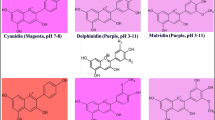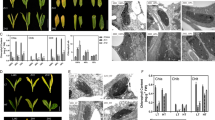Abstract
Tomato (Solanum lycopersicum L.) is one of the most important and popular vegetables worldwide. A wide range of tomato cultivars with different colored fruits is presently available. The purple peel of tomato fruit is due to the accumulation anthocyanin pigments, which are beneficial to both plants and humans. Cultivated tomatoes normally do not make anthocyanin in their fruit peel, but there are some wild relatives of cultivated tomato like Solanum chilense, S. habrochaites, S. cheesmanii, and S. lycopersicoides that do produce anthocyanins in their fruits. In this study, the purple fruit color was obtained by crossing ‘OSU blue’ (blue fruit) and ‘Purple mini’ (brown fruit) and subsequent self-pollination. Anthocyanins are produced via the flavonoid pathway and are regulated by the transcriptional complex of MYB, bHLH, and WD40 repeats transcription factors. We determined the expression profiles of genes related to anthocyanin biosynthesis in tomato genotypes with distinct fruit colors by qRT-PCR. Both the early and late biosynthetic genes of the anthocyanin pathway were up-regulated in the peels of purple tomato fruits, except Sl5GT. Moreover, the expression of the regulatory genes SlANT1 and SlAN1 was dramatically increased in the peels of purple tomato fruits. These results indicate that SlANT1 and SlAN1 might play an important role on anthocyanin biosynthesis in the peels of purple-fruited tomatoes via up-regulation of structural genes in the anthocyanin pathway.





Similar content being viewed by others
References
Abdel-Aal EM, Young JC, Rabalski I (2006) Anthocyanin composition in black, blue, pink, purple, and red cereal grains. J Agric Food Chem 54:4696–4704
Allan AC, Hellens RP, Laing WA (2008) MYB transcription factors that colour our fruit. Trends Plant Sci 13:99–102
Al-Sane K, Povero G, Perata P (2011) Anthocyanin tomato mutants: overview and characterization of an anthocyanin-less somaclonal mutant. Plant Biosyst 145:436–444
Ballester et al (2010) Biochemical and molecular analysis of pink tomatoes: deregulated expression of the gene encoding transcription factor SlMYB12 leads to pink tomato fruit color. Plant Physiol 152:71–84
Ban Y, Honda C, Hatsuyama Y, Igarashi M, Bessho H, Moriguchi T (2007) Isolation and functional analysis of a MYB transcription factor gene that is a key regulator for the development of red coloration in apple skin. Plant Cell Physiol 48:958–970
Barros L, Dueñas M, Pinela J, Carvalho AM, Buelga CS, Ferreira IC (2012) Characterization and quantification of phenolic compounds in four tomato (Lycopersicon esculentum L.) farmers’ varieties in northeastern Portugal home gardens. Plant Foods Hum Nutr 67:229–234
Boches PS (2009) Breeding tomato for increased fruit phenolics. Ph.D. Thesis, Oregon State University, Corvallis 2009
Bovy A, Schijlen E, Hall RD (2007) Metabolic engineering of flavonoids in tomato (Solanum lycopersicum): the potential for metabolomics. Metabolomics 3:399
Burton-Freeman B, Sesso HD (2014) Whole food versus supplement: comparing the clinical evidence of tomato intake and lycopene supplementation on cardiovascular risk factors. Adv Nutr 5:457–485
Butelli et al (2008) Enrichment of tomato fruit with health-promoting anthocyanins by expression of select transcription factors. Nat biotechnolo 26:1301–1308
Cheung AY, McNellis T, Piekos B (1993) Maintenance of chloroplast components during chromoplast differentiation in the tomato mutant green flesh. Plant Physiol 101:1223–1229
Chiu L, Li L (2012) Characterization of the regulatory network of BoMYB2 in controlling anthocyanin biosynthesis in purple cauliflower. Planta 236:1153–1164
Chiu LW, Zhou X, Burke S, Wu X, Prior RL, Li L (2010) The purple cauliflower arises from activation of a MYB transcription factor. Plant Physiol 154:1470–1480
Conn S, Curtin C, Bezier A, Franco C, Zhang W (2008) Purification, molecular cloning, and characterization of glutathione S-transferases (GSTs) from pigmented Vitis vinifera L. cell suspension cultures as putative anthocyanin transport proteins. J Exp Bot 59:3621–3634
Dubos C, Stracke R, Grotewold E, Weisshaar B, Martin C, Lepiniec L (2010) MYB transcription factors in Arabidopsis. Trends Plant Sci 15:573–581
Espley RV, Hellens RP, Putterill J, Stevenson DE, Kutty-Amma S, Allan AC (2007) Red colouration in apple fruit is due to the activity of the MYB transcription factor, MdMYB10. Plant J 49:414–427
Georgiev C (1972) Anthocyanin fruit (Af). Tomato Genet Coop Rpt 22:10
Gonzalez A, Zhao M, Leavitt JM, Lloyd AM (2008) Regulation of the anthocyanin biosynthetic pathway by the TTG1/bHLH/Myb transcriptional complex in Arabidopsis seedlings. Plant J 53:814–827
Gonzali S, Mazzucato A, Perata P (2009) Purple as a tomato: towards high anthocyanin tomatoes. Trends Plant Sci 14:237–241
Gould KS (2004) Nature’s Swiss Army Knife: the diverse protective roles of anthocyanins in leaves. J Biomed Biotechnol 2004:314–320
He Q, Zhang Z, Zhang L (2015) Anthocyanin accumulation, antioxidant ability and stability, and a transcriptional analysis of anthocyanin biosynthesis in purple heading Chinese Cabbage (Brassica rapa L. ssp. pekinensis). J Agric Food Chem 64:132–145
Holick CN, Michaud DS, Stolzenberg-Solomon R, Mayne ST, Pietinen P, Taylor PR, Virtamo J, Albanes D (2002) Dietary carotenoids, serum beta-carotene, and retinol and risk of lung cancer in the alpha-tocopherol, beta-carotene cohort study. Am J Epidemiol 156:536–547
Holzapfel NP, Holzapfel BM, Champ S, Feldthusen J, Clements J, Hutmacher DW (2013) The potential role of lycopene for the prevention and therapy of prostate cancer: from molecular mechanisms to clinical evidence. Int J Mol Sci 14:14620–14646
Jones CM, Mes P, Myers JR (2003) Characterization and inheritance of the Anthocyanin fruit (Aft) tomato. J Hered 94:449–456
Kiferle C, Fantini E, Bassolino L, Povero G, Spelt C, Buti S, Giuliano G, Quattrocchio F, Koes R, Perata P (2015) Tomato R2R3-MYB proteins SlANT1 and SlAN2: same protein activity, different roles. PLoS ONE 10:e0136365
Kobayashi S, Ishimaru M, Hiraoka K, Honda C (2002) Myb-related genes of the Kyoho grape (Vitis labruscana) regulate anthocyanin biosynthesis. Planta 215:924–933
Koes R, Verweij W, Quattrocchio F (2005) Flavonoids: a colorful model for the regulation and evolution of biochemical pathways. Trends Plant Sci 10:236–242
Lim S, Song J, Kim D, Kim JK, Lee J, Kim Y, Ha S (2016) Activation of anthocyanin biosynthesis by expression of the radish R2R3-MYB transcription factor gene RsMYB1. Plant Cell Rep 35:641–653
Lin-Wang K, Bolitho K, Grafton K, Kortstee A, Karunairetnam S, McGhie TK, Espley RV, Hellens RP, Allan AC (2010) An R2R3 MYB transcription factor associated with regulation of the anthocyanin biosynthetic pathway in Rosaceae. BMC Plant Biol 10:50
Livak KJ, Schmittgen TD (2001) Analysis of relative gene expression data using real-time quantitative PCR and the 2 − ΔΔCT method. Methods 25:402–408
Mano H, Ogasawara F, Sato K, Higo H, Minobe Y (2007) Isolation of a regulatory gene of anthocyanin biosynthesis in tuberous roots of purple-fleshed sweet potato. Plant Physiol 143:1252–1268
Mathews H, Clendennen SK, Caldwell CG, Liu XL, Connors K, Matheis N, Schuster DK, Menasco DJ, Wagoner W, Lightner J, Wagner DR (2003) Activation tagging in tomato identifies a transcriptional regulator of anthocyanin biosynthesis, modification, and transport. Plant Cell 15:1689–1703
Mazza G, Kay CD, Cottrell T, Holub BJ (2002) Absorption of anthocyanins from blueberries and serum antioxidant status in human subjects. J Agric Food Chem 50:7731–7737
Mehrtens F, Kranz H, Bednarek P, Weisshaar B (2005) The Arabidopsis transcription factor MYB12 is a flavonol-specific regulator of phenylpropanoid biosynthesis. Plant Physiol 138:1083–1096
Mes PJ, Boches P, Myers JR, Durst R (2008) Characterization of tomatoes expressing anthocyanin in the fruit. J Am Soc Hortic Sci 133:262–269
Paran I, van der Knaap E (2007) Genetic and molecular regulation of fruit and plant domestication traits in tomato and pepper. J Exp Bot 58:3841–3852
Petroni K, Tonelli C (2011) Recent advances on the regulation of anthocyanin synthesis in reproductive organs. Plant Sci 181:219–229
Povero G, Gonzali S, Bassolino L, Mazzucato A, Perata P (2011) Transcriptional analysis in high-anthocyanin tomatoes reveals synergistic effect of Aft and atv genes. J Plant Physiol 168:270–279
Rahim MA, Busatto N, Trainotti L (2014) Regulation of anthocyanin biosynthesis in peach fruits. Planta 240:913–929
Rick C, Reeves A, Zobel R (1968) Inheritance and linkage relations of four new mutants. Tomato Genet Coop Rep 18:34–35
Rick C, Cisneros P, Chetelat R, DeVerna J (1994) Abg-a gene on chromosome 10 for purple fruit derived from S. lycopersicoides. Rep Tomato Genet Coop 44:29–30
Ryan KG, Swinny EE, Markham KR, Winefield C (2002) Flavonoid gene expression and UV photoprotection in transgenic and mutant Petunia leaves. Phytochemistry 59:23–32
Sapir M, Oren-Shamir M, Ovadia R, Reuveni M, Evenor D, Tadmor Y, Nahon S, Shlomo H, Chen L, Meir A, Levin I (2008) Molecular aspects of anthocyanin fruit tomato in relation to high pigment-1. J Hered 99:292–303
Schaart JG, Dubos C, De La Fuente Romero, Irene Houwelingen AM, Vos RC, Jonker HH, Xu W, Routaboul J, Lepiniec L, Bovy AG (2013) Identification and characterization of MYB-bHLH-WD40 regulatory complexes controlling proanthocyanidin biosynthesis in strawberry (Fragaria × ananassa) fruits. New Phytol 197:454–467
Schreiber G, Reuveni M, Evenor D, Oren-Shamir M, Ovadia R, Sapir-Mir M, Bootbool-Man A, Nahon S, Shlomo H, Chen L (2012) ANTHOCYANIN1 from Solanum chilense is more efficient in accumulating anthocyanin metabolites than its Solanum lycopersicum counterpart in association with the ANTHOCYANIN FRUIT phenotype of tomato. Theor Appl Genet 124:295–307
Schwinn K, Venail J, Shang Y, Mackay S, Alm V, Butelli E, Oyama R, Bailey P, Davies K, Martin C (2006) A small family of MYB-regulatory genes controls floral pigmentation intensity and patterning in the genus Antirrhinum. Plant Cell 18:831–851
Shen X, Zhao K, Liu L, Zhang K, Yuan H, Liao X, Wang Q, Guo X, Li F, Li T (2014) A role for PacMYBA in ABA-regulated anthocyanin biosynthesis in red-colored sweet cherry cv. Hong Deng (Prunus avium L.). Plant Cell Physiol 55:862–880
Spelt C, Quattrocchio F, Mol JN, Koes R (2000) Anthocyanin1 of Petunia encodes a basic helix–loop–helix protein that directly activates transcription of structural anthocyanin genes. Plant Cell 12:1619–1632
Stevens M, Rick C (1986) Genetics and breeding. In: Atherton JG, Rudich J (eds) The tomato crop: a scientific basis for improvement, pp 35–105
Stommel JR, Lightbourn GJ, Winkel BS, Griesbach RJ (2009) Transcription factor families regulate the anthocyanin biosynthetic pathway in Capsicum annuum. J Am Soc Hortic Sci 134:244–251
Stracke R, Werber M, Weisshaar B (2001) The R2R3-MYB gene family in Arabidopsis thaliana. Curr Opin Plant Biol 4:447–456
Torres CA, Davies NM, Yanez JA, Andrews PK (2005) Disposition of selected flavonoids in fruit tissues of various tomato (Lycopersicon esculentum Mill.) genotypes. J Agric Food Chem 53:9536–9543
Veerappan K, Jung HJ, Hwang I, Kho KH, Chung MY, Nou IS (2016) Sequence variation in SlMYB12. Hortic Environ Biotechnol 57:274–279
Wada T, Kunihiro A, Tominaga-Wada R (2014) Arabidopsis CAPRICE (MYB) and GLABRA3 (bHLH) control tomato (Solanum lycopersicum) anthocyanin biosynthesis. PLoS ONE 9:e109093
Whitney KD, Lister CE (2004) Fruit colour polymorphism in Acacia ligulata: seed and seedling performance, clinal patterns, and chemical variation. Evol Ecol 18:165–186
Winkel-Shirley B (2001) Flavonoid biosynthesis. A colorful model for genetics, biochemistry, cell biology, and biotechnology. Plant Physiol 126:485–493
Yuan Y, Chiu L, Li L (2009) Transcriptional regulation of anthocyanin biosynthesis in red cabbage. Planta 230:1141–1153
Zhang J, Zhang Y, Dou Y, Li W, Wang S, Shi W, Sun Y, Zhang Z (2017) Single nucleotide mutation in FvMYB10 may lead to the yellow fruit in Fragaria vesca. Mol Breed 37:35
Zuluaga DL, Gonzali S, Loreti E, Pucciariello C, Degl’Innocenti E, Guidi L, Alpi A, Perata P (2008) Arabidopsis thaliana MYB75/PAP1 transcription factor induces anthocyanin production in transgenic tomato plants. Funct Plant Biol 35:606–618
Acknowledgements
This research was supported by the Golden Seed Project (Center for Horticultural Seed Development, Grant No. 213007-05-2-CG100) of the Ministry of Agriculture, Food and Rural affairs in the Republic of Korea (MAFRA). We thank Hyundai Seed Co. Ltd. and Gana Seed Co. Ltd., Republic of Korea for providing plant materials.
Author information
Authors and Affiliations
Corresponding author
Ethics declarations
Conflict of interest
The authors declare no conflict of interest.
Rights and permissions
About this article
Cite this article
Kang, SI., Rahim, M.A., Afrin, K.S. et al. Expression of anthocyanin biosynthesis-related genes reflects the peel color in purple tomato. Hortic. Environ. Biotechnol. 59, 435–445 (2018). https://doi.org/10.1007/s13580-018-0046-7
Received:
Revised:
Accepted:
Published:
Issue Date:
DOI: https://doi.org/10.1007/s13580-018-0046-7




